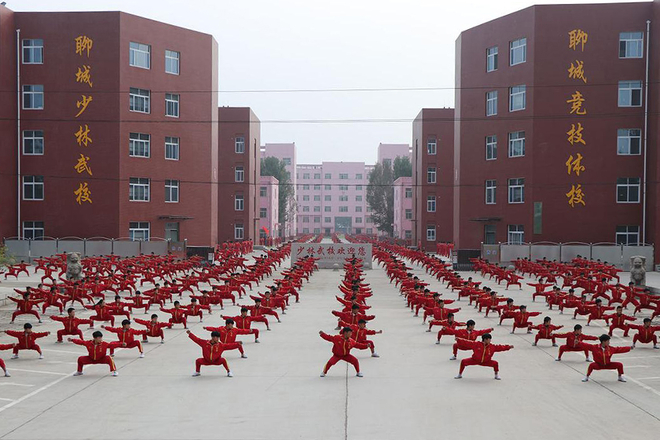Five Days After Enrollment, They Took a Leap (AI Translation)
Listen to the full version


文|财新 范俏佳,卢丹云(实习)
By Caixin's Fan Qiaojia, Lu Danyun (Intern)
【财新网】吃过晚饭,13岁的柳棋和同学小马翻过学校食堂二楼的窗户,先后从五米高的窗台跳下。
[Caixin Online] After dinner, 13-year-old Liu Qi and his classmate Xiao Ma climbed over the second-floor window of the school cafeteria and jumped down one after the other from a five-meter high ledge.
两辆救护车的警报声划破夜空,此时是2023年11月4日,距离柳棋进入山东聊城市少林武校仅过去五天。
The wail of two ambulance sirens pierced the night; it was November 4, 2023, only five days after Liu Qi had entered the Shaolin Martial Arts School in Liaocheng City, Shandong Province.
柳棋说,自己有恐高症,跳下去前很害怕。他见到小马跳下去后躺地上抱着腿大叫,但仍跟着纵身一跃。因为这是他想到唯一能出去的办法——“摔残了也比在这里强。”
Liu Qi admitted that he suffers from acrophobia and was terrified before jumping. He saw Xiao Ma jump and then lay on the ground clutching his leg and screaming, but Liu Qi followed suit. This was the only way he could think of to escape—"Even being injured is better than staying here."

- DIGEST HUB
- Children at Liaocheng Martial Arts School faced harsh conditions, corporal punishment, and a lack of proper education, leading to incidents like Liu Qi's jump to escape.
- Martial arts schools often employ closed, militarized management and corporal punishment, attracting rural families seeking discipline but often neglecting students' well-being.
- Despite safety guidelines, violence and abuse cases in martial arts schools remain frequent due to poor regulation and oversight.
**Summary of the Article:**
In Liaocheng City, Shandong Province, two 13-year-olds, Liu Qi and Xiao Ma, attempted to escape from the Shaolin Martial Arts School due to the harsh conditions, with Liu Qi stating he would rather be injured than stay in the school. Liu Qi, characterized as sensitive and academically struggling, was sent to the school by his grandmother in hopes of reforming his behavior, despite the school's reputation for harsh military-style management [para. 1][para. 2][para. 3].
Liu Qi’s experience at the martial arts school involved waking early, performing chores, and obeying rigid orders without attending academic or martial arts lessons. Disobedience led to corporal punishment, as witnessed by Liu Qi, who saw other students beaten by coaches. The lack of communication means, like mobile phones, left students isolated and unable to report mistreatment to parents [para. 4][para. 5][para. 6].
The culture of concern around "problematic teens" in such schools is illustrated by another case, Yu Tian, whose parents sent him to the school to cure his internet addiction. The school's methods included physical labor, and corporal punishment was a common disciplinary tool. Students often suffered physical abuse, and incidents of beatings were reported [para. 7][para. 8][para. 9][para. 10].
Martial arts schools like Liaocheng's often attract students from rural areas, promoted by parents hoping for behavioral reform and educational enhancement. There remains a notable gap between expectations and reality since post-graduation opportunities are limited for many students. Cases of students returning home with psychological scars, like depression, are not uncommon, reflecting the schools' harmful impacts [para. 11][para. 12][para. 13].
The legal and regulatory side sees prominent issues too. In Liu Qi’s case, his escape led to severe injuries, but persisting legal challenges reflected difficulties in proving school's negligence. The closed climate of such institutions and cultural barriers in discussion disrupt supervision and accountability, evidenced by ongoing litigious processes where schools often bear less responsibility than sought [para. 14][para. 15][para. 16][para. 17].
Violence in martial arts schools is not isolated to Liaocheng. National examples show this as a recurring theme, leading to injuries or even death among students. In response, regulatory documents like the "Safety Management Guidelines for Martial Arts Schools" were released to intensify oversight, but implementation remains inconsistent across regions[para. 18][para. 19][para. 20][para. 21].
This narrative of Liu Qi and beyond throws light on martial arts schools' role in a broader socio-educational issue about how societal perceptions of ‘rebellion’ prompt extreme measures without treating underlying personal or systemic challenges. There is a crucial urge for a scientific approach to childhood education and the behavioral management conceptualization among parents and schools alike [para. 22][para. 23][para. 24].
The article outlines broader systemic issues entailing how parents' desperation for behavioral improvements in their children leads them to institutions with questionable management and regulatory oversight, thus warranting fundamental reforms to better support and evaluate educational institutions like martial arts schools.
- PODCAST
- MOST POPULAR





 Sign in with Google
Sign in with Google
 Sign in with Facebook
Sign in with Facebook
 Sign in with 财新
Sign in with 财新